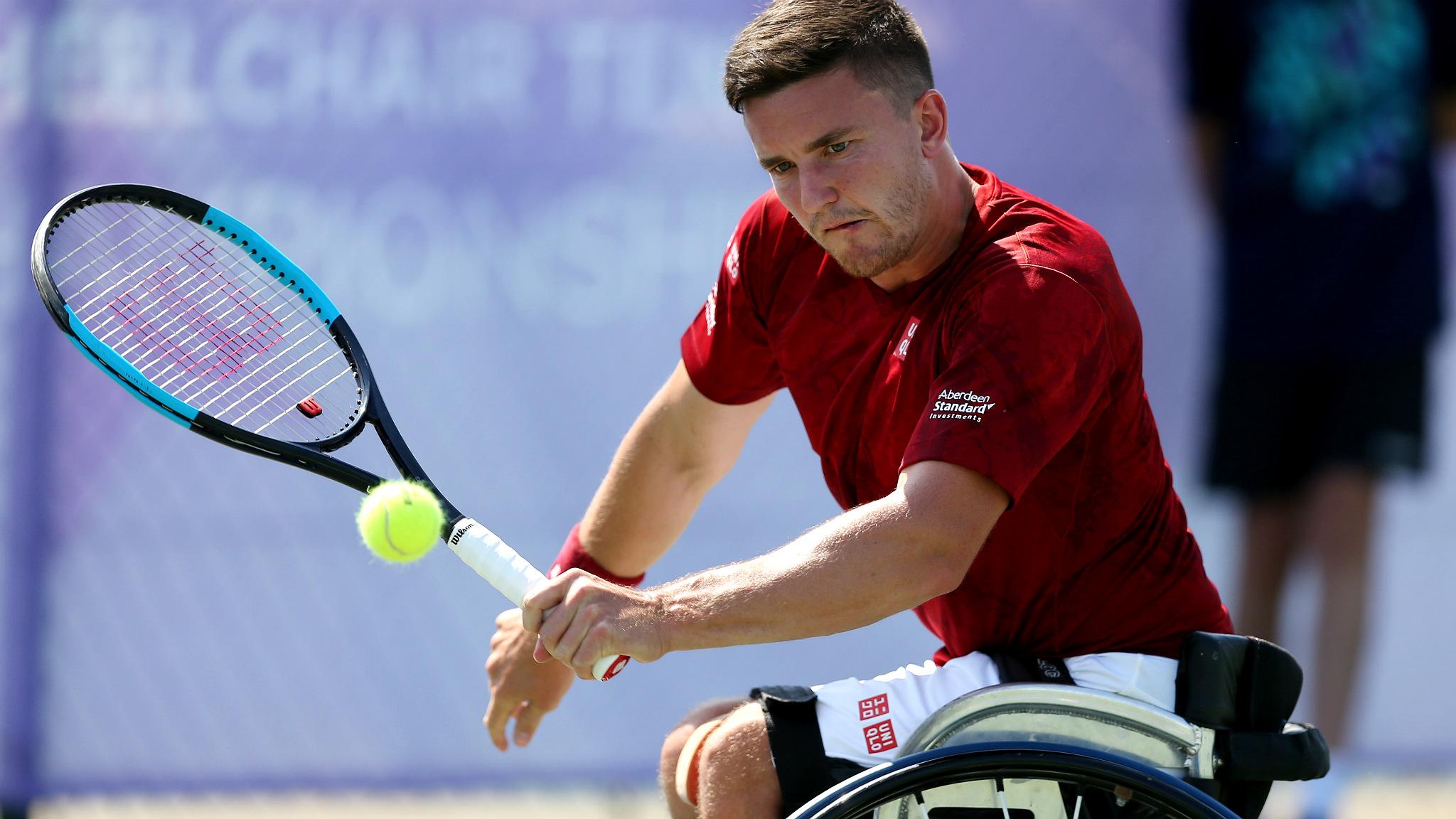Wimbledon 2015: How players and fans cope with record heat
- Published
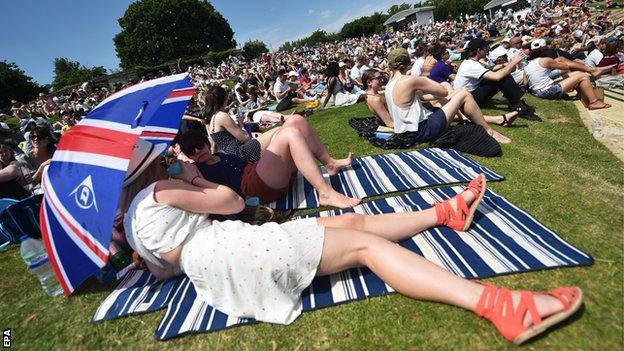
Fans protect themselves from the sun in patriotic fashion
It's official: Wimbledon was baking hot.
Hotter than it had ever been, in fact. The temperature in SW19 reached 35.7C on Wednesday, and it even touched 41.2C on Centre Court., external
"I was starting to get dizzy out there with the heat hitting me," said Australia's 27th seed Bernard Tomic.
Not all the players complained. Some revelled in it - as did most of the sun-baked spectators, who were armed with sun cream, water, shades, hats and even parasols.
BBC Sport analyses the record-breaking heat which sizzled Wimbledon.
How did the near 100F temperatures affect the players?
Hottest Day at Wimbledon
Every player would probably answer this question differently - and unfortunately we were unable to poll every single competitor at Wimbledon.
However, Spain's two-time champion Rafael Nadal had fun in the sun, according to his trainer and uncle Toni Nadal.
"For us, it is good to play with the sun because normally Majorca has lots of sun. Rafa feels good about this type of weather," he told BBC Sport.
Nadal senior said the unexpected temperatures in south-west London did not change his nephew's game plan or his hydration techniques before, during or after matches.
How do players prepare for competing in hot weather?
Those players born and raised in warmer climates - including Nadal - have a natural advantage.
Others without that upbringing, like Scotland's Andy Murray, use warm-weather training in Florida and scientific formulas to prepare their bodies.
Anyone who has played sport - and anyone who has learned basic biology - knows that a human becomes soaked with salty sweat when they are taking part in physical activity.
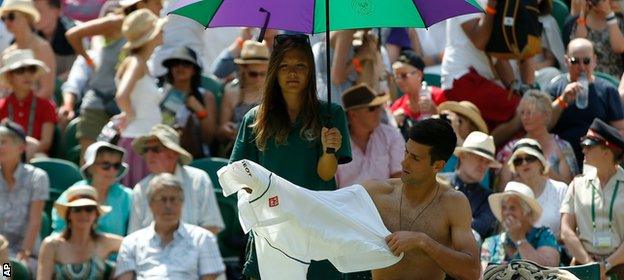
Changing shirts and taking shelter were tactics used by world number one Novak Djokovic
"The prime thing for tennis players is the need to balance sweat loss by taking on enough fluids so it doesn't impair their performance," James Collins, head of nutrition for Arsenal Football Club, told BBC Sport.
"That depends on electrolytes, which control the fluid balance of the body. They are key because they help the body to absorb more fluid in the intestines and retain more.
"The electrolyte content that they take on is absolutely critical. Just taking on water can actually dilute it quickly and won't hydrate them properly."
What techniques do they use to cope?
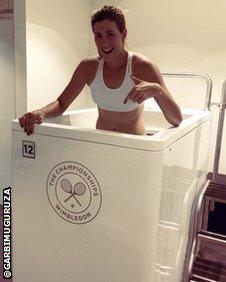
Garbine Muguruza, the 20th seed, tweeted this picture of her icy recovery methods after practice
Plenty of amateur sportsmen pop to the shop ahead of a match to stock up on glucose-based drinks and a pack of sugary sweets.
Elite sport stars are much better prepared, but we are not that different. They guzzle energy drinks and neck fruit-flavoured snacks.
"Sports drinks have two needs. One is hydration to take on water and electrolytes, the other is to have carbohydrates to fuel the muscles," said Collins,, external who advised England at the 2014 World Cup and has also worked with British Olympians.
"A lot of players take on sweets or gels to replace carbohydrates, but they also have some electrolytes in there.
"All of our national teams now use gels, which are really good and popular because they can be digested quickly. These come in all sorts of flavours - cherry, orange, cola, anything."
What about afterwards? A pint of lager and a pack of smoky bacon crisps? Not a chance.
"Elite players all have a cooling strategy. Some use ice collars, some use ice jackets - whatever it is, each individual will have practised their cooling strategy."
How does the Wimbledon heat compare with other Grand Slams?
Wimbledon 2015: Temperatures soar on day three
Well, even the olive-skinned Toni Nadal admitted he needed to apply sun cream as he watched 10th seed Rafael during his first-round match on Tuesday.
But he said the heat was no harder for players to deal with than at the Australian Open, held in January in Melbourne, or September's US Open in New York.
"Australia is the hottest Slam," he said.
What did the players say?
Australia's Bernard Tomic, who grew up in the Queensland city of Gold Coast, is one player who admitted he was feeling the heat.
"I just haven't been sleeping well here. It's been too hot, I was fatigued and starting to get dizzy out there with the heat hitting me."
Maria Sharapova, the 2004 women's champion, disagreed - although the Russia-born fourth seed now lives in the sunshine American state of Florida.
"It's much warmer in my hometown of Long Boat Key. There was some cloud coverage here and I've trained quite long in the heat over there," she said.

Tomic won 7-6 (7-3) 6-4 7-6 (7-5) in his second-round tie against France's Pierre-Hugues Herbert on Wednesday
"It's about the preparation in understanding it's going to be warm and not going for it too much because you want to make the points quicker than normal because of the heat.
"You need to be a little bit smarter out there, that is the most important thing."
Ice-cool seven-time champion Roger Federer said the conditions were "totally fine" after winning his first-round match in straight sets on Tuesday.
"It was perfect playing conditions, to be honest. It was nice. No clouds whatsoever."
Did the heat put spectators off?
Shuffling along packed gangways and squeezing into busy court seating would suggest not.
The queue for non-tickets holders - about 9,600 strong on the opening two days - was shorter on Wednesday morning. However, at 16:00 BST, organisers warned queuing hopefuls not to turn up because Wimbledon was "at its capacity".
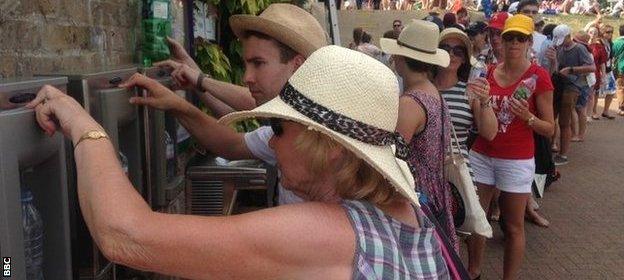
Spectators were queuing to fill up their water bottles outside court 18 on Wednesday afternoon
There was not much natural cover for those in the long queue which snaked along Wimbledon Park Golf Club and on to Wimbledon Park itself.
Wimbledon Park resembles the site of a music festival, thousands camping overnight as they patiently wait to catch a glimpse of their heroes.
Wimbledon's daily maximum capacity was slightly reduced by organisers on Tuesday to compensate for the heat and provide "more comfortable conditions" for spectators.
How have people working at Wimbledon coped?
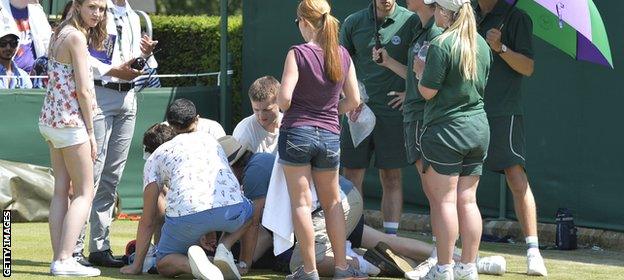
A ball boy collapsed during a match between Australia's Matthew Ebden and John Isner of the United States but was fine after a check-up.
St John Ambulance, the charity which handles emergency calls at Wimbledon, said it took four people to hospital by 15:00 BST on Wednesday because of heat-related illness. Almost 400 others have needed treatment within the grounds this week.
It said 96 people needed attention on Monday, 173 on Tuesday and 170 on Wednesday.
Most of those were for complaints of feeling faint or suffering from slight dehydration and headaches.
Security staff, employed by G4S, were allowed to remove their ties - but all kept on their hats for protection from the sun.
Is it going to get hotter?
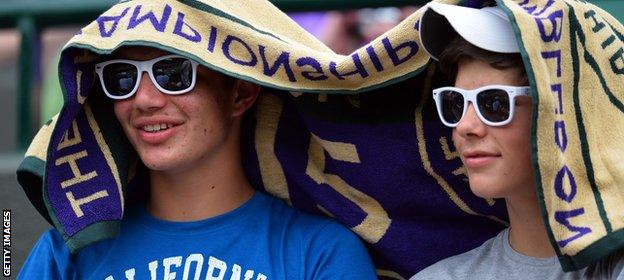
Fans even used towels to protect themselves from the London sun
Play has never been suspended at Wimbledon because of the heat - and that looks set to continue. But still bring the sunscreen if you are heading down to SW19.
"After record heat at Wimbledon it looks like the most stifling conditions have passed," said BBC Weather's Jake Cope.
"Thundery showers through Thursday morning will bring lower temperatures, around 25C, and a much fresher feel through a dry afternoon and evening.
"On Friday the mercury will nudge 30C but nothing threatening Wednesday's record high. Through the weekend and into next week, we won't see such high temperatures."
What was the previous hottest Wimbledon?
Those old enough to remember that the summer of 1976 will wistfully tell you that Britain was "hotter than the sun".
It wasn't. But it was baking, setting the benchmark for British heatwaves. Dry rivers, droughts, a water ban, Government intervention...
Before Wednesday, the hottest temperature at Wimbledon was recorded on 26 June, 1976 when it reached a blistering 34.6C.
History.
- Published1 July 2015

- Published1 July 2015
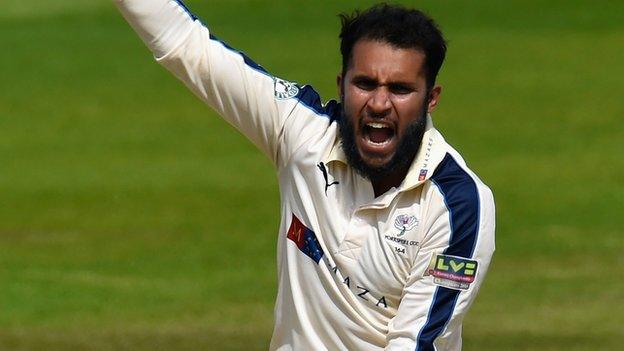
- Published1 July 2015
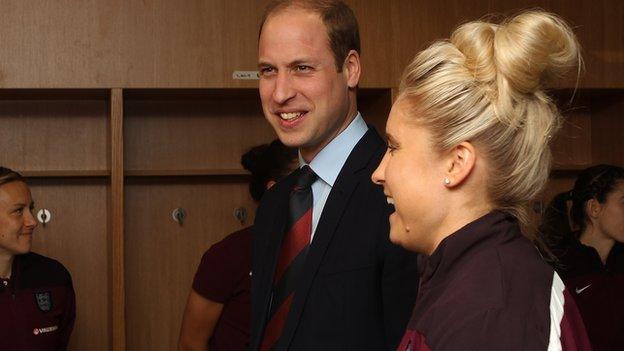
- Published1 July 2015

- Published1 July 2015

- Published8 November 2016

- Published9 November 2016

- Published17 June 2019
